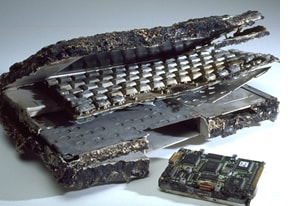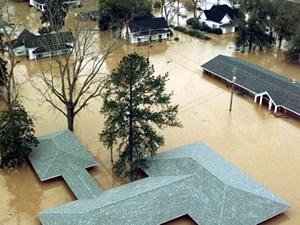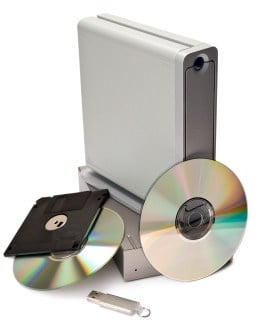 Many of us here within the PeakProsperity.com community were introduced to the need of preparedness through watching the Crash Course and later exploring the WSID Guide and Blog. As personal awareness grew, many of us started to look at emergencies and situations that would have a dramatic and profound affect on our lives, and we began to make preparations to deal with those emergencies and build more resiliency into our lives.
Many of us here within the PeakProsperity.com community were introduced to the need of preparedness through watching the Crash Course and later exploring the WSID Guide and Blog. As personal awareness grew, many of us started to look at emergencies and situations that would have a dramatic and profound affect on our lives, and we began to make preparations to deal with those emergencies and build more resiliency into our lives.
We started to evaluate our water, food, and housing security more closely and to make sure we had backup plans and resources. Health, wealth, and community became a bigger concern for many of us, as we learned more about the state of the systems we rely on so heavily and their overall decline in supporting us in the future.
With all of the situations and concerns we look at when building resiliency into our lives, one topic that gets overlooked frequently is our “digital lives” and how to protect them from catastrophe. The majority of us are perpetually connected to a digital life. Everything from banking and financial records, contracts, business documents, and our personal photos and memories are all stored on a hard drive somewhere as binary 1’s and 0’s.
 We sometimes forget that we rely on hard drives and mass storage media to safeguard hundreds and sometimes thousands of hours worth of work and resources. Some of this digital life is stored locally (home/office computers), some in the “cloud,” and some of it in remote locations that we have no control over. So with this in mind, I would like to explore a few concepts on this topic and give the PeakProsperity.com community a starting point to begin thinking about protections and resiliency in our “digital self.”
We sometimes forget that we rely on hard drives and mass storage media to safeguard hundreds and sometimes thousands of hours worth of work and resources. Some of this digital life is stored locally (home/office computers), some in the “cloud,” and some of it in remote locations that we have no control over. So with this in mind, I would like to explore a few concepts on this topic and give the PeakProsperity.com community a starting point to begin thinking about protections and resiliency in our “digital self.”
Digital catastrophe can happen at any time. The loss of your digital self can be as small as losing your mobile phone with the past three months of photos on it, or the complete loss of a hard drive that contains every file you have ever worked on since using a computer. And that loss can be caused by any number of things: theft, fire, flood, a spilled cup of coffee, or just plain hardware failure from old or low-quality parts.
 I want you take a moment to think about losing every file, photo, bookmark, password, and email you have and trying to start over from scratch. What about that address book? Do you still have those Windows XP install discs? Could you remember that random website you bookmarked about building your own solar panels? What about all the account info and passwords for your various financial and service accounts? Would your have access to these items if the house burned down or you needed to evacuate during a natural disaster? How much time and energy would it take to rebuild those resources, and how would you feel about the loss of those irreplaceable memories?
I want you take a moment to think about losing every file, photo, bookmark, password, and email you have and trying to start over from scratch. What about that address book? Do you still have those Windows XP install discs? Could you remember that random website you bookmarked about building your own solar panels? What about all the account info and passwords for your various financial and service accounts? Would your have access to these items if the house burned down or you needed to evacuate during a natural disaster? How much time and energy would it take to rebuild those resources, and how would you feel about the loss of those irreplaceable memories?
So lets look at backing up our data and our "digital selves" by starting with some general techniques and considerations. There are lots of options out there, and I hope this summary with help you develop a backup strategy that works best for you.
Back Up Your Data! Redundancy is the Key.
 My overall recommended strategy is to have redundancy in one's backups. This means having two constantly updated copies of your data: One on-site (local) and one off-site in a secure location. As mentioned before, there are lots of options and technologies to achieve this strategy, and everyone will have a different plan that works best for them and meets their needs. I won’t go into specifics in this article, but I will give a general overview of this strategy and how its applied.
My overall recommended strategy is to have redundancy in one's backups. This means having two constantly updated copies of your data: One on-site (local) and one off-site in a secure location. As mentioned before, there are lots of options and technologies to achieve this strategy, and everyone will have a different plan that works best for them and meets their needs. I won’t go into specifics in this article, but I will give a general overview of this strategy and how its applied.
On-Site Backup
This is the process of copying your entire system or vital files to an external drive or writable media (USB Hard Drive, NAS Drive, Memory Stick/Thumb Drive, CD/DVD). Copying can be done manually by dragging and dropping selected files or using a backup software to assist in automating the process. Most computer systems come with a backup software suite that allows you to do full backups and incremental copies of your entire system on a designated schedule.
Advantages of having an on-site backup:
- Readily accessible to replace a failed drive or find a deleted or corrupt file
- Can be set up easily and does not cost anything beyond the initial setup
- Can be transported easily to a service center or secure location as needed
- Faster backup times for copying large volumes of data
Disadvantages:
- Backup data and hardware is vulnerable to being destroyed (fire, flood, power surge, etc.) or stolen along with the original data
Off-Site Backup
Off-site options include either a physical copy that you make on-site and put in a remote location (safe deposit box or trusted family/friend's home, perhaps in another city/state) or the utilization of an online backup service to copy your files to a remote location (Mozy, Carbonite, and DropBox are some examples). With off-site backup, your data is secured in a location separate from your original data.
Advantages of having off-site backup:
- Backup data does not have the same vulnerabilities as your original data, simply because it is not in the same place at the same time
- Online backup services usually provide remote access to your data from anywhere (assuming online access is available)
Disadvantages:
- More expensive in the long term, as online services usually have an ongoing fee
- Moving hardware requires more time and possible expense (shipping or personally delivering backup hardware to off-site location)
- Not easily accessible for rapid replacement
- Online backup can be slow for uploading and downloading large amounts of data
- Online systems have potential security issues (e.g., hacking, identity theft)
Criticality and Capacity
Now that we have a general overview of ways to safeguard data, let's look at what data is absolutely critical to back up and what level of storage is necessary to create full backups and scheduled snapshots on a continuous basis.
I work on a computer ten hours a day and having access to all my files and applications is critical to performing my job, so having complete and full copies of my entire system and setup is a must. If my hard drive were to fail suddenly, I could use a full backup copy to replace the drive in a matter of hours, compared to the multiple days it would take to backup 140 GB of data over the web or re-install all my applications and remember all my passwords.
For a lot of people, just backing up their personal files and memories will be sufficient. In general, though, backing up the entire system can save a lot of time and headache when disaster does strike.
For the amount of data storage a person needs, I like to use a ratio of 1 to 3. For every 1 GB of data, I like to have 3 GB of external storage capacity to backup the data. So for a 100 GB internal hard drive on your computer, you should try to have 300 GB of backup storage available. This allows you to have multiple snapshots on one device in case you need to access an older backup. (Perhaps you really do need that file you deleted from six months ago that is not in your most recent snapshot.)
These days, hard drive space is pretty cheap. You can get a 1000 GB hard drive for under a $100, and this seems like a pretty reasonable investment for ensuring that your data will be around when you need it.
Conclusion
When conducting a new or revised self-assessment of your resiliency and preparations -- looking over the water supply, the long term food storage, and the emergency equipment -- I strongly encourage you to include an evaluation of your data backup plan. If you don't have one in place, there is no better time than right now to get started. If you have a plan actively in place, check the health and security of your equipment to make sure all is in order. Just like cars, computer systems and hardware need maintenance to work properly and keep your data safe.
I hope this has given you a better understanding of the need for data backups and possible solutions to move towards to give you a little piece on mind with regards to protecting your digital self. Look for more on this topic in future articles.
Cheers,
Jason
Resources:
- Wikipedia Entry on Backups
- Windows 7 Backup and Restore
- Acronis PC Backup
- Mac Time Machine
- SuperDuper for Mac
- External Hard Drives
- Online Backup Services Mozy | Carbonite | DropBox
This What Should I Do? blog series is intended to surface knowledge and perspective useful to preparing for a future defined by Peak Oil. The content is written by PeakProsperity.com readers and is based in their own experiences in putting into practice many of the ideas exchanged on this site. If there are topics you'd like to see featured here, or if you have interest in contributing a post in a relevant area of your expertise, please indicate so in our What Should I Do? series feedback forum.
If you have not yet seen the other articles in this series, you can find them here:
- Selecting a Firearm (Aaron Moyer)
- The Basics of Growing Garlic (karenbyler)
- Using & About Oxygen Absorbers (deniskorn)
- Vermiculture: Getting down and dirty with worms (jasonw)
- Starting your investment plan (Travlin)
- Getting In Shape: The New Me (cmartenson)
- Slow Money: Getting the “Numb” Out of Numbers (woodytasch)
- Preserving Meat By Curing and Smoking (DanJab)
- Raising Children in Changing Times (DianneM)
- Argentina: A Case Study in How An Economy Collapses (FerFAL)
- Wood Gasification: An Intriguing Emergency Fuel Source (Dutch John)
- Whole Food Eating (Teresa Piro)
- The Case for Small Scale Biofuels (Ready)
- Preparing for Economic Collapse (FerFAL)
- Buying a House in Today's Market (Patrick Killelea)
- How To Increase The Energy Efficiency of Your Existing Home (zeroenergy21)
- Fortifying Yourself And Your Home Against Crime (thc0655)
- Food Storage Made Easy (Adam)
- Quick Primer on Contamination Control Measures (Dogs_In_A_Pile)
- Practical Survival Skills 101 - Understanding Emergencies (Aaron Moyer)
- How to Explain the Current Economic Situation to Friends & Family (rhare)
- Managing Pain Without Meds (JAG)
- Protecting Yourself Against Crime and Violence (thc0655)
- Cultivating Inner Resilience in the Face of Crisis (suziegruber)
- Problem Solving: Improvise, Adapt, Overcome (Mooselick7)
- Extending the Harvest in Your Home Garden (Woodman)
- Practical Survival Skills 101 - Obtaining Shelter (Aaron Moyer)
- Woodworking (bklement)
- Making Soap (maceves)
- Small-Scale Beekeeping (apismellifera)
- Practical Survival Skills 101 - Water (Aaron Moyer)
- Prepping on a Shoestring (Amanda)
- Making the Urban-to-Rural Transition (joemanc)
- Dealing With a Reluctant Partner (Becca Martenson)
- Raising Your Own Chickens (Woodman)
- Practical Survival Skills 101 - Fire Starting (Aaron Moyer)
- A Quiet Revolution in Bicycles: Recapturing a Role as Utilitarian People-Movers - Part 2 (Cycle9)
- A Quiet Revolution in Bicycles: Recapturing a Role as Utilitarian People-Movers - Part 1 (Cycle9)
- The Keys to Transitioning Healthcare: Empowerment, Education, & Prevention (suziegruber)
- Installing A Solar Energy System (rhare)
- The Essential Gardening and Food Resilience Library (Old Hippie)
- Creating Healthy Snacks from Your Garden (EndGamePlayer)
- Peak Certainty, Food Resilience, and Aquaponics (Farmer Brown)
- A Case Study in Creating Community (SagerXX)
This series is a companion to this site's free What Should I Do? Guide, which provides guidance from Chris and the PeakProsperity.com staff on specific strategies, products, and services that individuals should consider in their preparations.
This is a companion discussion topic for the original entry at https://peakprosperity.com/considering-data-backup-2/